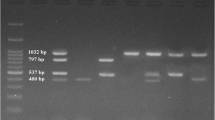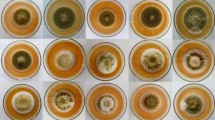Abstract
Fusarium species are dominant within the sorghum grain mold complex. Some species of Fusarium involved in grain mold complex produce mycotoxins, such as fumonisins. An attempt was made to identify Fusarium spp. associated with grain mold complex in major sorghum-growing areas in India through AFLP-based grouping of the isolates and to further confirm the species by sequencing part of α-Elongation factor gene and comparing the sequences with that available in the NCBI database. The dendrogram generated from the AFLP data clustered the isolates into 5 groups. Five species of Fusarium—F. proliferatum, F. thapsinum, F. equiseti, F. andiyazi and F. sacchari were identified based on sequence similarity of α-Elongation factor gene of the test isolates with those in the NCBI database. Fusarium thapsinum was identified as predominant species in Fusarium—grain mold complex in India and F. proliferatum as highly toxigenic for fumonisins production. Analysis of molecular variance (AMOVA) revealed 54% of the variation in the AFLP patterns of 63 isolates was due to the differences between Fusarium species, and 46% was due to differences between the strains within a species.



Similar content being viewed by others
References
Thakur RP, Rao VP, Navi SS, Garud TB, Agarkar GD, Bharati B. Sorghum grain mold: variability in fungal complex. Int Sorg Mill Newsl. 2003;4:104–8.
Leslie JF, Zeller KA, Lamprecht SC, Rheeder JP, Marasas WFO. Toxicity, pathogenicity, and genetic differentiation of five species of Fusarium from sorghum and millet. Phytopathology. 2005;95:275–83.
Vasanthi S, Bhat RV. Mycotoxins in food occurrence, health and economic significance and food control measures. Indian J Med Res. 1998;108:212–22.
Bhat RV, Shetty PH, Amruth RP, Sudershan RV. A foodborne disease outbreak due to the consumption of moldy sorghum and maize containing fumonisins mycotoxins. J Toxicol-Clin Toxic. 1997;35:249–55.
Bhat RV, Beedu SR, Ramakrishna Y, Munshi KL. Outbreak of trichothecene mycotoxicosis associated with consumption of mould damaged wheat products in Kashmir valley, India. Lancet. 1989;7:35–7.
Eller MS, Holland JB, Payne GA. Breeding for improved resistance to fumonisin contamination in maize. Toxin Rev. 2008;27:371–89.
Navi SS, Girish AG, Thakur RP, Yang XB. Banana leaves as a substitute for carnation leaves in characterizing Fusarium spp. Phytopathology. 2006;96:S83.
Kim DH, Martyn RD, Magill CW. Restriction fragment length polymorphism groups and physical map of mitochondrial DNA from Fusarium oxysporum f. sp. niveum. Phytopathology. 1992;82:346–53.
Vos P, Hogers R, Bleeker M, van de Lee T, Hornes M, Frijters A, Pot J, Peleman J, Kuiper M, Zabeau M. AFLP: a new technique for DNA fingerprinting. Nucleic Acids Res. 1995;23:4407–14.
Rohlf FJ. NTSYS-pc: Numerical taxonomy and multivariate analysis system version 2.2. Exeter Software: Setauket, New York; 2000.
Excoffier L, Smouse P, Quattro L. Analysis of molecular variance inferred from metric distances among DNA haplotypes: application to human mitochondrial restriction data. Genetics. 1992;131:479–91.
O’Donnel K, Kistler HC, Cigelnik E, Ploetz RC. Multiple evolutionary origins of the fungus causing Panama disease of banana: concordant evidence from nuclear and mitochondrial gene genealogies. Proc Natl Acad Sci. 1998;95:2044–9.
Altschul SF, Madden TL, Schaffer AA, Zhang JH, Zhang Z, Miller W, Lipman DJ. Gapped BLAST and PSI-BLAST: a new generation of protein database search programs. Nucleic Acids Res. 1997;25:3389–402.
Reddy SV, Mayi DK, Reddy MU, Devi KT, Reddy DVR. Aflatoxins B1 in different grades of chillies (Capsicum annum L.) in India as determined by indirect competitive-ELISA. Food Addit Contam. 2001;18:553–8.
Yu FY, Chu FS. Production and characterization of antibodies against Fumonisin B1. J Food Protect. 1996;59:992–7.
Waliyar F, Reddy SV, Kumar PL. Review of immunological methods for the quantification of aflatoxins in peanut and other foods. Peanut Sci. 2009;36:54–9.
Thakur RP, Reddy BVS, Indira S, Rao VP, Navi SS, Yang XB, Ramesh S. Sorghum Grain Mold. Information Bulletin No. 72. International Crops Research Institute for the Semi-Arid Tropics, Patancheru 502324, Andhra Pradesh, India; 2006.
Leslie JF, Summerell BA. The Fusarium laboratory manual. 1st ed. Ames, USA: Blackwell Publishing Professional; 2006. p. 388.
Bacon CW, Nelson PE. Fumonisin production in corn by toxigenic strains of Fusarium moniliforme and Fusarium proliferatum. J Food Protect. 1994;57:514–21.
Dantzer WR, Pomettoi ALI, Murphy PA. Fumonisin B1 production by Fusarium proliferatum strain M5991 in a modified Myro liquid medium. Nat Toxins. 1996;4:168–73.
Proctor RH, Plattner RD, Brown DW, Seo JA, Lee YW. Discontinuous distribution of fumonisin biosynthetic genes in the Gibberella fujikuroi species complex. Mycol Res. 2004;108:815–22.
Bryden WL, Logrieco A, Abbas HK, Porter JK, Vesonder RF, Richard JL, Cole RJ. Other significant Fusarium mycotoxins. In: Summerell BA, Leslie JF, Backhouse D, Bryden WL, Burgess LW, editors. Fusarium: Paul E. Nelson Memorial Symposium. APS Press, St. Paul, Minnesota; 2001. pp. 360–392.
Leslie JF, Marasas WFO, Shephard GS, Syndenham EW, Stockenstrom S, Thiel PG. Duckling toxicity and the production of fumonisin and moniliformin by isolates in the A and F mating populations of Gibberella fujikuroi. Appl Environ Microb. 1996;62:1182–7.
Miedaner T, Löffler M, Bolduan C, Kessel B, Ouzunova M, Mirdita V, Melchinger AE. Genetic variation for resistance, mycotoxin content of European maize inoculated with Fusarium graminearum, F. verticillioides. Cereal Res Commun. 2008;36:45–8.
Acknowledgments
The research was supported by The Sehgal Foundation Endowment Fund instituted at the International Crops Research Institute for the Semi-Arid Tropics (ICRISAT), Patancheru—502324, AP, India.
Author information
Authors and Affiliations
Corresponding author
Rights and permissions
About this article
Cite this article
Sharma, R., Thakur, R.P., Senthilvel, S. et al. Identification and Characterization of Toxigenic Fusaria Associated with Sorghum Grain Mold Complex in India. Mycopathologia 171, 223–230 (2011). https://doi.org/10.1007/s11046-010-9354-x
Received:
Accepted:
Published:
Issue Date:
DOI: https://doi.org/10.1007/s11046-010-9354-x




